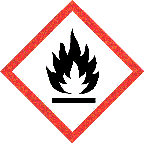bigdave789:
That sounds correct, I have seen similar situations with a couple of pallets of household bleach on a trailer with pallets of fabric conditioner and washing up liquid.
The black and white sticker covers you for this.
Now what qualifies as a limited quantity, I’m not sure
Hi bigdave789,
That’s where the devil is in the detail mate, so it’s not surprising that there’s a lot of mystery about it. 
Some goods are only hazardous, but hazardous is NOT the same as dangerous.
Hazardous goods have their own labels, which are normally there to inform the user of the goods that the goods are hazardous to them in some way.
The hazardous goods labelling system is being changed, so you could see this old one for flammability:

OR the new version:

If those (or similar) are the only labels, then anybody can carry any amount because the ‘stuff’ is only hazardous.
Screen-wash and anti-freeze are normally carried by using the above labels.
The same ‘stuff’ in a very concentrated form is actually dangerous goods (UN 1993) and are in UN Class 3 as ‘dangerous’ goods.
A UN Class 3 label looks like this:

By use of the ‘small load’ exemption, non-ADR trained drivers can carry some packaged dangerous goods but there is a limit (depending on severity of danger) to how much is allowed to be carried on the vehicle.
In this case, ‘packaged’ means drums, boxes, IBCs, jerricans and crates etc = the normal types of package.
There is a separate exemption, normally used in the retail sector, which is called Limited Quantities (LQs.)
To answer your question about what qualifies as LQs, the LQ exemption is best thought of as the kind of dangerous goods that can be bought over the counter in a retail shop, things like paint, adhesive, ink, perfume, fertiliser AND when packaged in a form (smallish) used for retail sale. Different substances have different allowable LQ receptacle sizes.
When packaged in this way, a consignment can be shipped as LQs, using this label:

When carrying LQs, there is NO LIMIT to the amount loaded, AND the vast majority of the ADR rules DON’T apply.
There are limits to the receptacle size and the max weight of a box or tray, and a couple of labelling/marking requirements, but these are for the sender to get right. The sender also MUST inform the carrier (your boss) of the shipment.
When carrying LQs, there is a placarding rule for vehicles.
A vehicle of >12t permitted GVW carrying >8t of LQ goods must display a 250mm X 250mm (= placard) version of the LQ label above.
The driver needs to have some form of documented ADR awareness, (NOT an ADR licence) but this doesn’t have to be carried on board the vehicle.
Just to be clear… a 7.5t vehicle carrying a full load of LQs does NOT need placards.
A full sized artic carrying **<**8t of LQs does NOT need placards.



